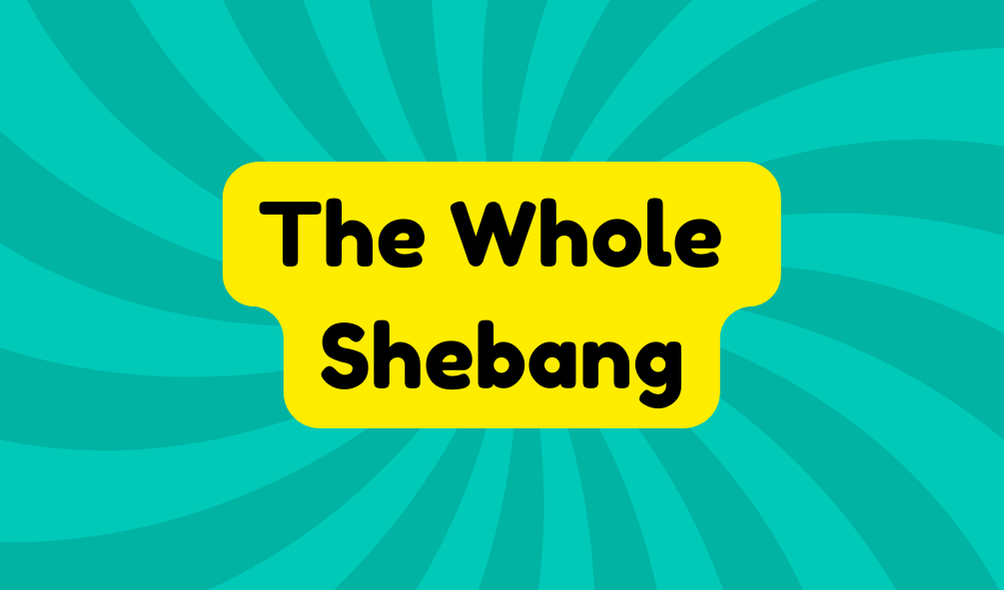"The whole shebang" is an informal phrase that signifies completeness or totality across various contexts. Originating in the 1920s, it carries a sense of everything included without leaving anything out. This expression has synonyms like "the whole kit and caboodle" and "the whole nine yards," each underscoring the idea of entirety. While it's useful in everyday conversation, one might question its impact on clarity. To understand its full significance, one may want to examine its origins and usage further.
Synonyms
Synonyms for the phrase "the whole shebang" highlight the concept of completeness in various contexts. This expression captures the idea of embracing all aspects within a defined scope, or the complete package. Often used in informal conversations, it signifies that nothing is left out, encapsulating the essence of an entire affair. Here are four notable alternatives:
- The whole kit and caboodle
- The whole nine yards
- The whole ball of wax
- The whole enchilada
These phrases, while creative, serve an important function: they reinforce a sense of totality, enriching our language with layers of meaning.
Example of Sentences
The expression "the whole shebang" frequently appears in various contexts, showcasing its versatility in language. Sentence applications of this phrase can inject emphasis into conversations, revealing a sense of completeness. Here are some practical examples:
- "When they planned the event, they included the whole shebang – food, entertainment, and decorations."
- "After weeks of preparation, she finally shared the whole shebang of her project with the team."
- "He offered to sell his car along with the whole shebang: tools, tires, and accessories."
- "During the presentation, she covered the whole shebang, leaving no details overlooked."
These examples highlight the phrase's adaptability and effective communication.
Origin
Language evolves in intriguing ways, and the phrase "the whole shebang" is no exception. Its etymological roots can be traced back to the 1920s, deriving from "shebang," which once referred to a simple dwelling. The cultural significance of this phrase lies in its embodiment of completeness, serving as a linguistic marker that captures collective experiences. Early uses in literature by figures like Walt Whitman and Mark Twain demonstrate its versatility. While some connections to British vernacular exist, they remain circumstantial. Consequently, the term reflects both a rich historical background and the continuous evolution of language within society.
Collocations
Collocations related to the phrase "the whole shebang" highlight its versatility in everyday language. These everyday expressions serve as cultural markers, revealing the significance of complete ideas.
- Complete the whole shebang
- Go for the whole shebang
- Enjoy the whole shebang
- Experience the whole shebang
Each collocation enriches communication, offering listeners a clear sense of totality. However, one must question whether these expressions dilute meaning or enhance clarity. While innovative language evolves, the challenge remains to maintain authenticity without falling into cliché. Understanding these collocations empowers users, enabling precise expression in diverse contexts.
How to Use in Everyday Language
In casual conversations, using the phrase "the whole shebang" can convey a sense of completeness, but it's important to apply it thoughtfully. Within informal settings, such as friendly chats or lighthearted discussions, this expression can effectively emphasize that everything is included. However, overusing it may lead to misunderstandings or dilute its impact. Readers should be mindful of context; while it fits nicely in everyday conversations, excessive use in serious discussions can come across as flippant. Ultimately, knowing when to incorporate this phrase can enhance communication, ensuring it adds value rather than obfuscating the message.
Why Is It Still Relevant Today?
Despite its whimsical nature, the phrase "the whole shebang" continues to hold significance in modern communication, reflecting a cultural tendency towards efficiency and clarity. Today, this expression embodies the desire for complete understanding in a fast-paced world, resonating across diverse mediums. Its cultural significance is evident as it adapts to contemporary discussions, making it relevant in contexts ranging from casual conversation to technology and business. Modern adaptations showcase how language evolves, encapsulating entire concepts in a compact form. While some may question its informal charm, the phrase undeniably enriches communication, reminding audiences of the value of totality in expression.







